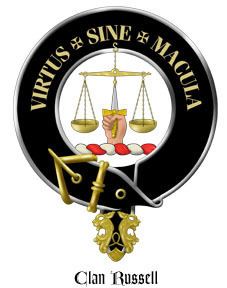Last Chief Baron Rozel | ||
 | ||
Motto Virtus sine macula.(Virtue without a stain) Historic seat Aden in Aberdeenshire, various other locations in Scotland | ||
Clan Russell is a Scottish armigerous clan, with claimed origins in Normandy. It has ancestral ties to the English Dukes of Bedford, and has numerous descendants in Great Britain and America.
Contents
Origins of the clan
The surname Russell appears to be derived from rous which means red. The name was commonly found amongst the Normans and French people as the personal name of Rufus. Between 1164 and 1177 Walter Russel witnessed a charter in favour of Paisley Abbey. Mentioned in a charter of about 1180 is John, son of Robert Russel of Duncanlaw. In 1259 Robert Russel witnessed a deed relating to the lands of Threipland.
Wars of Scottish Independence
In 1296 Robert Russel appears on the Ragman Rolls giving homage to Edward I of England. Historian William Anderson stated that the name of Russel came to Aberdeenshire with one Rozel who was an English baron who fought at the siege of Berwick and the Battle of Halidon Hill in 1333. Rozel subsequently settled in Scotland and obtained the estate of Aden. His family was styled 'Russel of that Ilk'.
17th, 18th and 19th centuries
Patrick Russel was married to a sister of Archbishop Sharp and in 1680 he purchased the lands of Moncoffer in Banffshire. From him descend the Scottish Barons of Aden, Aberdeenshire. The Russel of Ashiesteel family in Selkirkshire were particularly distinguished in military service. Between 1756 and 1767 Colonel William Russel of Ashiesteel was adjutant general of the army of Madras and served under General Lord Clive. His son was Major General Sir James Russel who also served in India and commanded a brigade of cavalry at the Battle of Mahidpur.
Alexander Russell was an eminent doctor and naturalist and in 1756 published a Natural History of Aleppo.
In England, the descendants of Rufus became Dukes of Bedford. The third son of the sixth Duke was John Russell who studied at the University of Edinburgh where he greatly admired the independent and democratic philosophy of the Scots. In politics he was the architect of the first Reform Act 1832 and served as Prime Minister of the United Kingdom. He was created Earl Russell in 1861. His grandson was Bertrand Russell who was one of the great philosophers of the twentieth century.
